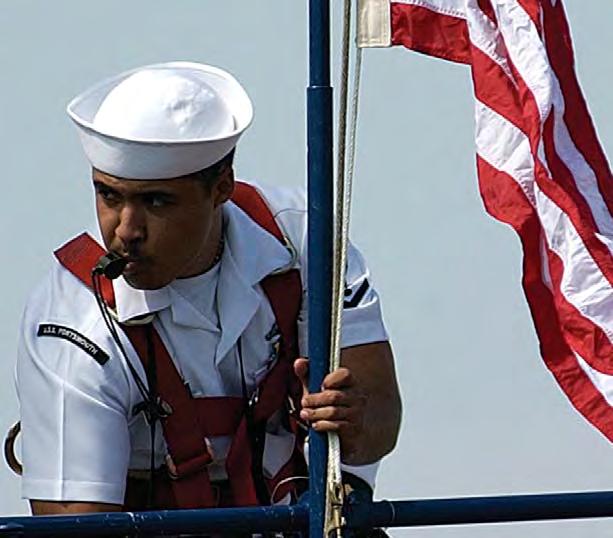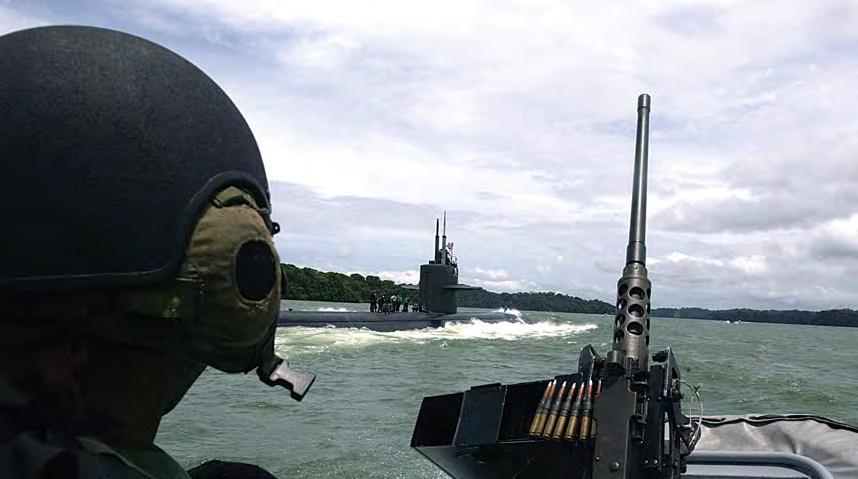
6 minute read
USS Portsmouth Deactivates After 21 Years of Service
The 21-year career of the Los Angelesclass submarine USS Portsmouth (SSN-707) came to an end this summer, as the attack submarine traveled to Virginia to deactivate.
Portsmouth left San Diego in late summer on route to the Norfolk Naval Shipyard, where the crew held a decommissioning ceremony in September. They will then work through the winter, dismantling the boat that has been a second home to hundreds of Sailors since the early 1980s.
Advertisement
Photo by PH1 David A. Levy
MM3 Adan Rodriguez raises the National Ensign as Portsmouth prepares to get underway.
USS Portsmouth Deactivates After 21 years of Service 21 years of Service

Portsmouth Commanding Officer, CDR Kevin Brenton and ET3 Guillermo Juarez conduct a sunset lookout watch.
Portsmouth was commissioned 1 October 1983, in Portsmouth, New Hampshire, one of its two namesake cities. Ironically, her other namesake is Portsmouth, Virginia, home of the Norfolk Naval Shipyard, where she will be deactivated. Three weeks after its commissioning, Portsmouth headed to the Caribbean to support the U.S. overthrow of the island nation of Grenada’s violent Marxist dictatorship. A few months later, the boat transited the Panama Canal to reach San Diego, her permanent homeport. While assigned to San Diego, the boat has embarked on nine extended cruises and three shorter deployments.
“A budget decision had to be made about the boat. It is more than 20 years old, and we’re reaching the end of the reactor core life,” Portsmouth’s commanding officer CDR Kevin Brenton explained. “We either had to refuel or decommission.”
(right) MMC David Noel, Leading Chief Torpedoman assigned to Portsmouth, performs a pre-load inspection inside a torpedo tube.
(below) Portsmouth’s crew conduct’s a hot run toxic gas drill while underway.
Photo by PH1 David A. Levy

Photo by PH1 David A. Levy

If Portsmouth remained in the fleet, extensive structural testing in a dry dock setting would have been conducted, an expensive but necessary process for submarines remaining in service beyond their first 20 years, Brenton said. As a Los Angeles-class submarine, the boat is capable of serving the fleet for at least another 10 years. According to CDR Brenton, however, Navy officials have decided to divert the funds the boat would need to stay in service to newer submarines.
He stressed the decision to retire Portsmouth early had nothing to do with the boat’s accomplishments or its record in the fleet. The boat has earned four Meritorious Unit Commendations and five Battle Efficiency (Battle “E”) awards over the years, along with the Navy Commendation Medal and numerous awards recognizing superior performance by several departments, including engineering, navigation, and supply.
“It is an extremely proud crew and ship. P ortsmouth has maintained a great reputation for many, many years,” said CDR Brenton, explaining his own disappointment in seeing the boat leave the fleet.
“No commanding officer wants to give up the reins and go into the shipyard to watch their ship taken apart,” he said, explaining many of the boat’s parts will be used for other submarines and smiling at the idea of Portsmouth’s spirit supporting the fleet aboard those other boats.
It has only been a few months since Portsmouth supported the fleet itself. Portsmouth returned to San Diego from a six-month Western Pacific deployment in February. Two months later, Brenton and his crew learned of the decision to decommission the boat. Even after receiving the disappointing news, they traveled to the Gulf of Alaska in June to protect the aircraft carrier, USS John C. Stennis (CVN74), during Northern Edge, an annual air exercise. Now the crew is preparing for their transit to the East Coast and for the dismantling process that will begin once they get there.
“Our last deployment was this lady’s last dance, and it was a great one,” said Portsmouth’s Chief of the Boat, Master Chief Electronics Technician Daniel Adley. During the deployment that ended in February, the boat visited several ports, including cities in Japan, Singapore, and Hawaii.
Photo by PH1 David A. Levy

Photo by PH2 John Parker

(above) EM1 Eric Cherry stan ds watch on the sail bridge as Portsmouth transits the Panama Canal.
(left) Mobile Security Detachment 22 (MSD-22), stationed at Naval Shipyard, Portsmouth, Virginia provides security for Portsmouth as she transits the Panama Canal.
(right) Portsmouth Crewmembers leap into the waters of the Pacific Ocean during a swim call.
USS Portsmouth Serves with Distinction for More Than Two Decades
Serving for more than 20 years, USS Portsmouth conducted nine extended deployments and three mini-deployments. She was awarded six Meritorious Unit Commendations, the Silver Anchor Award for excellence in retention, the Engineering Red “E”, the Supply Blue “E”, five Battle Efficiency “E” awards, and a Navy Expeditionary Medal. In 1993, Portsmouth pioneered new methods of Special Warfare when she conducted an insertion of Army Rangers during a night joint exercise. On 6 June 2002, Portsmouth sank her one and only ship, ex-USS Okinawa (LPH-3) during a COMSUBPAC SINKEX off the southern coast of California.

Portsmouth launches in Groton, Connecticut on 18 September 1982
According to Adley, the crew of a submarine is often more cohesive than that of a surface ship because of the close quarters submariners live in. There isn’t space on submarines for “Officers’ Country,” an area most surface ships set aside for the exclusive use of commissioned officers. Submarines also lack space for a “Chief’s Mess,” which means all enlisted Sailors eat together on the mess decks. On surface ships, senior enlisted Sailors eat in a separate area from their junior counterparts. Among the tight-knit submarine crews Adley has worked with during his 23 years in the service, he said Portsmouth is one of the best.
Although some of Portsmouth’s Sailors will stay with their boat until the very end, others will start transitioning to new commands as early as October. Brenton said culinary specialists, sonar technicians, and other crewmembers with specialties not directly related to maintaining the boat’s structure will be the first to leave. Nuclear technicians will be among the last.
Brenton said he considers the Sailors in his crew among the best and brightest young people in the United States today. He’d like America to know his Sailors have made many sacrifices in their personal lives to help their boat accomplish its missions out of dedication to Portsmouth, to the Navy, and to their country.
“Without the 160-or-so Sailors I have onboard, this boat is just a hunk of metal, wires, and hydraulic fluid,” Brenton said. “They work with a sense of pride and professionalism that keeps me in awe everyday. Even though Portsmouth is going away, the Sailors will remain and bring that pride and professionalism to every ship they serve on in the future.”
JO1(SW)Leahy, Public Affairs Center San Diego
Photo by PH1 David A. Levy

MM2 Tom Mitchell says goodbye to his son before getting underway.
Photo by PH1 David A. Levy










